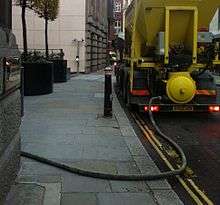Screed
Screed has three meanings in building construction. 1) a flat board (screed board, floating screed) or a purpose-made aluminium tool used to smooth and true materials like concrete, stucco and plaster after it has been placed on a surface or to assist in flattening;[1] 2) a strip of plaster or wood applied to a surface to act as a guide for a screed tool (screed rail, screed strip, screed batten); 3) the material itself which has been flattened with a screed (screed coat).[2] In the UK, screed has also come to describe a thin, top layer of material (traditionally sand and cement), poured in site on top of the structural concrete or insulation, on top of which other finishing materials can be applied, or it can be left bare to achieve a raw effect. It is becoming more common to use "self-leveling" poured screeds which use materials other than cement as their binder.
Screed boards


In the US, screeding is the process a person called a concrete finisher performs by cutting off excess wet concrete to bring the top surface of a slab to the proper grade and smoothness. A power concrete screed has a gasoline motor attached which helps smooth and vibrate concrete as it is flattened. After the concrete is flattened it is smoothed with a concrete float or power trowel. A concrete floor is sometimes called a solid ground floor.
A plasterer also may use a screed to level a wall or ceiling surface in plasterwork.
This sense of screed has been extended to asphalt paving where a free floating screed is part of a machine which spreads the pavement.
Screed rails

A weep screed or sill screed is a screed rail which has drainage holes to allow moisture which penetrated an exterior plaster or stucco coating to drain through the screed.[3]
Screed coats

A development in the UK is the delivery, mixing, and pumping of screed from a single vehicle. Where previously screed jobs required a separate pump to administer the screed, these new machines can now administer the screed directly from the mixing pan to the floor at a range of up to 60 meters. For example, the material called granolithic.
See also
- Screed wire, an alternate name for a ground wire in electrical work
- Screedboard, a proprietary gypsum board
References
- ↑ "Construction Dictionary". Website Upgrades Inc. 2000. Retrieved 2007-05-21.
- ↑ "screed, n. 3" and screed, v. 4." Oxford English Dictionary 2nd. ed. 2009. CD-rom.
- ↑ wisegeek.com accessed March 22, 2015
Sources
- Constructing Architecture - Materials, Processes, Structures: A Handbook; Andrea Deplazes (ed.); Birkhauser, 2005
| Look up screed in Wiktionary, the free dictionary. |